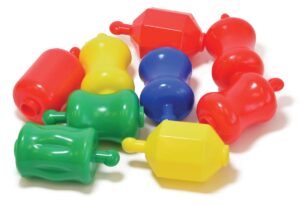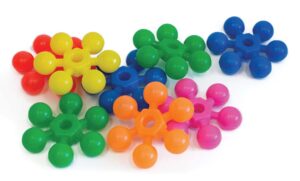Problem-solving, Object inquiry skills
Toddlers put together and pull apart snap beads.

Snap beads of different colors—5 per toddler


Be Prepared: Place all of the individual snap beads in the center of the table or floor space for this activity. The beads should be easily accessible to all participating toddlers. The activity description suggests an initial focus on making a chain of beads. A chain of up to five beads provides sufficient challenge for most toddlers, although you may wish to offer more beads. Some toddlers may wish to make a long chain or a circle with a larger number of beads. Make a chain of three beads prior to the activity and keep it nearby for use as an example if needed.
 Sit on the floor or at a table with several toddlers and ask how each of us can make a chain with the beads. Point to and describe several individual beads in the center of your area. Emphasize problem-solving questions that are appropriate for participating toddlers’ understandings:
Sit on the floor or at a table with several toddlers and ask how each of us can make a chain with the beads. Point to and describe several individual beads in the center of your area. Emphasize problem-solving questions that are appropriate for participating toddlers’ understandings:
Build on toddlers’ comments and efforts to put together the beads. Draw attention to a toddler’s work in making a chain with the beads. Show your prepared example of a chain of beads (see Be Prepared) only if toddlers seem unclear about what a chain looks like.
Encourage toddlers to pursue their interests in putting together the snap beads. A toddler may wish to make a long chain or several short chains or a circle. Talk about how a chain gets longer when a bead is added.
Invite toddlers to pull apart their chains (or circles) and create a new chain or circle. Using different or same colors may be of interest. Talk about how a chain gets shorter when a bead is taken off. It is not necessary for toddlers to count the beads.
See Extra Support tips if a toddler(s) has difficulty connecting or disconnecting the beads.
This activity extends and builds on the Block 2 Cognitive activity plan focused on taking apart (Option 1) and putting together (Option 2) a chain of snap beads. The current activity offers more beads and opportunities to both connect and disconnect beads. Watch for ways to provide additional support or enrichment. Toddlers will differ in their skills in manipulating snap beads, based on experiences with snap beads in your room and at home.
Similar to Block 2, the current activity promotes problem-solving skills as well as object inquiry. Observe toddlers’ reactions to your opening questions directly related to problem-solving and offer an example of a chain or demonstration of how to connect snap beads only if necessary. It is best for toddlers to figure out how to move forward with the beads.
Offering different colors of beads can enhance a toddler’s interest in and enjoyment of working with beads. Note that color is a part of several Scaffolding Tips. Encourage toddlers to connect and disconnect beads, not focus on connecting beads exclusively. Different coordination skills and understanding of a bead’s characteristics are involved in each. The opportunity to sort or use beads taken off a chain may heighten interest in disconnecting beads (see Enrichment tips).
Toddlers generally enjoy seeing the immediate results of their actions as they add beads and observe the bead length is getting longer. Likewise, toddlers will be interested in seeing how a bead chain gets shorter when they remove beads. Anticipate that toddlers may wish to “own” the beads they remove from a chain.
Extra support
Enrichment
Object inquiry skills
Toddlers put together star builders with an opportunity to also pull apart the builders in their creation.



Be Prepared: Place each of the individual star builders in the center of a low tabletop, separated so each builder can be readily seen (not in piles) and easily reached by participating toddlers.
 Invite several toddlers to each make something with star builders. Show and describe a builder. Ask toddlers how two star builders could be put together. Pause for one or more toddlers to show how to put together two builders. Describe the actions. If appropriate, demonstrate how to put together two builders (see Extra Support tip).
Invite several toddlers to each make something with star builders. Show and describe a builder. Ask toddlers how two star builders could be put together. Pause for one or more toddlers to show how to put together two builders. Describe the actions. If appropriate, demonstrate how to put together two builders (see Extra Support tip).
Encourage each toddler to make whatever he/she wishes by putting together some star builders. Emphasize that there are many different ways we can make something with star builders. Demonstrate several simple possibilities if toddlers have limited familiarity with the material.
Describe toddlers’ actions with the builders. Draw attention to how a creation gets bigger when a builder is added to it. Support individual creativity. Emphasize how each of the creations is unique.
Invite toddlers to pull apart the builders in their creation so they can build something different. If appropriate, demonstrate how to pull apart a set of connected builders (see Extra Support tip). Draw attention to how a creation gets smaller when we pull apart the builders.
This activity builds on the Block 2 Cognitive activity plan focused on taking apart a creation made with star builders (Option 3). The current activity offers the opportunity to put together two or more star builders. Star builders can be appropriately challenging for toddlers to use. Look for indications that your help is needed (see Extra Support tip). Some toddlers may wish to practice putting together and pulling apart star builders, and not pursue making something with the material.
Watch for opportunities to describe what toddlers are doing with the builders. Avoid saying what you think a toddler is making or asking what a toddler plans to make. It is likely a toddler will not have a clear image of what he/she intends to make, although a label may surface as a toddler puts together some builders. A toddler may decide that his/her creation is a caterpillar, for example, or a rocket. Approach this activity as creative exploration with a novel and rewarding material.
If a toddler asks you to build a particular shape for him/her, use encouragement and questions to help the toddler create the item on his/her own. Using star builders fosters creativity and fine motor skills that are not fully promoted if you create a structure for a child. If necessary, remind toddlers that we are not competing to make the biggest or longest item.
One of your jobs in the activity is to facilitate access to the star builders. Unused items should remain in the center of the table, not in a separate collection that a toddler may think is his/hers. Add materials if toddlers are sufficiently skilled in manipulating the star builders (see Enrichment tip).
Extra support
Enrichment
Problem-solving, Object inquiry skills
A toddler pulls apart and/or puts together blocks that connect.

Bristle Blocks® (see Be Prepared)


Be Prepared: Select 3–4 blocks that are appropriate to a toddler’s familiarity with the material. Providing too many items may distract a toddler’s attention from how the blocks can be put together and pulled apart. A set of Bristle Blocks® may include a range of different shapes, such as people figures and round items, that are not used in the current activity.
[Invite a toddler to join you on the floor or at a low table. Put two Bristle Blocks® in front of the toddler. Invite the toddler to use his/her fingers to feel a block.]
 These blocks are very bumpy! They are special blocks. We can put together the blocks. We can pull apart blocks that are together. These blocks are apart. They have not been put together.
These blocks are very bumpy! They are special blocks. We can put together the blocks. We can pull apart blocks that are together. These blocks are apart. They have not been put together.
[Repeat and expand the toddler’s comment. Examples: “You said ‘push.’ Yes, we can push them together with our hands, Kya.” “Huan, I heard you say, ‘pull.’ Yes! We can pull them apart with our hands.”]
[For putting together:
Describe and demonstrate how to put together two blocks, face to face. Examples: “We put the bumpy parts of the blocks next to each other and push just a little bit. The blocks stay together when we push them together.” “I am using two hands. I have one block in this hand and one block in this hand. I am going to push the two blocks together.”
Describe and demonstrate another way to put together the blocks: two blocks end to end.
Give the toddler two blocks to use in practicing the task of putting together.
For pulling apart:
Describe and demonstrate how to pull apart two blocks. Example: “I am holding one block with this hand. I am holding the other block with my other hand. Now I am pulling just a little bit. The blocks are pulled apart!”
Give the toddler two connected blocks to use in practicing the task of pulling apart.
Describe the toddler’s interactions with the toy. Examples: “Kya, you pushed with your two hands and the blocks went together!” “Look! You used both of your hands to pull apart the blocks!”
Encourage the toddler to describe what he/she is doing (or has done) with the blocks.
Change tasks. Example: If the toddler opted to first put together the blocks, encourage him/ her to now pull apart the blocks.
Provide 1–2 additional blocks if the toddler requests more.]
We worked with bumpy blocks today. We used our two hands to put together the blocks. We used two hands to take apart the blocks.
Bristle Blocks® are unique in the way they connect. A toddler may find the blocks relatively easy to put together but difficult to pull apart. The one-to-one setting of the current activity provides good opportunities for you to tailor the selection of blocks and individualize your support of a toddler’s explorations. Some toddlers may enjoy working with two blocks only as they practice the tasks of connecting and disconnecting. Other toddlers may easily work with more than two blocks (see Enrichment tip).
Extra support
Enrichment
Materials Needed: Bristle Blocks®, colored circles, large paper, glue, glue brushes, basket
Provide a basket of Bristle Blocks® in a play area for toddlers to manipulate. Encourage interested toddlers to practice putting together and pulling apart the blocks. Toddlers will enjoy putting colored circles on a large paper with glue. Provide toddler-size glue brushes, sturdy paper, and 5–10 circles for each child. Some toddlers will create a random design, and some toddlers may glue the circles in an overlapping line to resemble a caterpillar. On another day, add a sensory element to star builder construction. Place the star builders in a sensory table with warm, soapy water. Provide water smocks.
Materials Needed: Bristle Blocks®, beads, string, Unifix® cubes
Toddlers are not the only children in your setting who are likely to enjoy working with Bristle Blocks®. Preschool-age and older children may enjoy creating objects, such as houses and cars, with the blocks. Infants who show an interest in what other children are doing with the Bristle Blocks® may enjoy mouthing and exploring other blocks appropriate for their age. Preschool children will enjoy stringing beads on a string and watching it get longer. Provide other snap-together items, such as Unifix® cubes, for children to see the result of adding more.